

GitHub - sqshq/PiggyMetrics: Microservice Architecture with Spring Boot, Spring Cloud and Docker. Merging vs. Rebasing. The git rebase command has a reputation for being magical Git voodoo that beginners should stay away from, but it can actually make life much easier for a development team when used with care.

In this article, we’ll compare git rebase with the related git merge command and identify all of the potential opportunities to incorporate rebasing into the typical Git workflow. Conceptual Overview The first thing to understand about git rebase is that it solves the same problem as git merge. Both of these commands are designed to integrate changes from one branch into another branch—they just do it in very different ways. Consider what happens when you start working on a new feature in a dedicated branch, then another team member updates the master branch with new commits.
Now, let’s say that the new commits in master are relevant to the feature that you’re working on. The Merge Option The easiest option is to merge the master branch into the feature branch using something like the following: Mikeash.com: Friday Q&A 2015-09-04: Let's Build dispatch_queue. Friday Q&A 2015-09-04: Let's Build dispatch_queue Grand Central Dispatch is one of the truly great APIs to come out of Apple in the past few years.
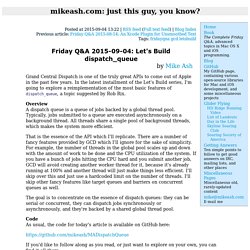
In the latest installment of the Let's Build series, I'm going to explore a reimplementation of the most basic features of dispatch_queue, a topic suggested by Rob Rix. OverviewA dispatch queue is a queue of jobs backed by a global thread pool. Typically, jobs submitted to a queue are executed asynchronously on a background thread. All threads share a single pool of background threads, which makes the system more efficient. That is the essence of the API which I'll replicate. The goal is to concentrate on the essence of dispatch queues: they can be serial or concurrent, they can dispatch jobs synchronously or asynchronously, and they're backed by a shared global thread pool.
Is building a container runtime, Rocket. Try it out: View the latest rkt docs or sample systemd units. rkt is a new container runtime, designed for composability, security, and speed.
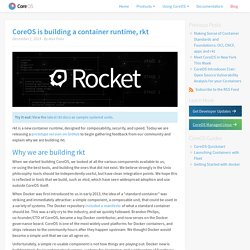
Today we are releasing a prototype version on GitHub to begin gathering feedback from our community and explain why we are building rkt. Why we are building rkt When we started building CoreOS, we looked at all the various components available to us, re-using the best tools, and building the ones that did not exist. We believe strongly in the Unix philosophy: tools should be independently useful, but have clean integration points. When Docker was first introduced to us in early 2013, the idea of a “standard container” was striking and immediately attractive: a simple component, a composable unit, that could be used in a variety of systems. MICROSERVICES - A REALITY CHECK(POINT) It’s reached the point where it’s even a cliche to state “there’s a lot written about Microservices these days.”
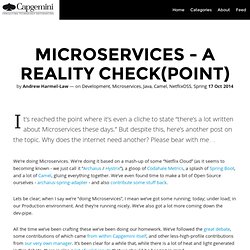
But despite this, here’s another post on the topic. Why does the internet need another? Please bear with me… We’re doing Microservices. We’re doing it based on a mash-up of some “Netflix Cloud” (as it seems to becoming known - we just call it “Archaius / Hystrix”), a gloop of Codahale Metrics, a splash of Spring Boot, and a lot of Camel, gluing everything together.
Intel-hadoop/gearpump · GitHub. Netflix/Hystrix. Cassandra. Overview Astyanax is one of Netflix’s more popular OSS Projects.
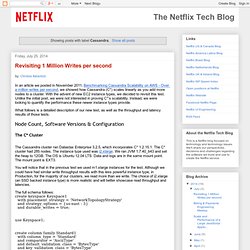
About a year ago, whenever we spoke with Cassandra users, Astyanax was considered the de facto Java Client library for Cassandra (C*) because of features such as connection pooling, intelligent load balancing between C* nodes as well as the Recipes. With the advent of the new Java Driver from DataStax, which has incorporated some of the best Astyanax concepts, many in the community have been wondering if Astyanax is still relevant.
HyperDex.org. Is HyperDex truly transactional?
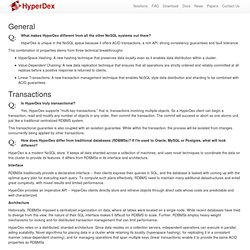
Yes. HyperDex supports "multi-key transactions," that is, transactions involving multiple objects. So a HyperDex client can begin a transaction, read and modify any number of objects in any order, then commit the transaction. The commit will succeed or abort as one atomic unit, just like a traditional centralized RDBMS system.
This transactional guarantee is also coupled with an isolation guarantee. How does HyperDex differ from traditional databases (RDBMSs)? HyperDex is a modern NoSQL store. Interface RDBMSs traditionally provide a declarative interface -- their clients express their queries in SQL, and the database is tasked with coming up with the optimal query plan for executing each query. HyperDex provides an imperative API -- HyperDex clients directly store and retrieve objects through direct calls whose costs are predictable and well-characterized. Blog.might.net. Compilers. GPS: A Graph Processing System. How the AOL.com Architecture Evolved to 99.999% Availability, 8 Million Visitors Per Day, and 200,000 Requests Per Second.
This is a guest post by Dave Hagler Systems Architect at AOL. The AOL homepages receive more than 8 million visitors per day. That’s more daily viewers than Good Morning America or the Today Show on television.